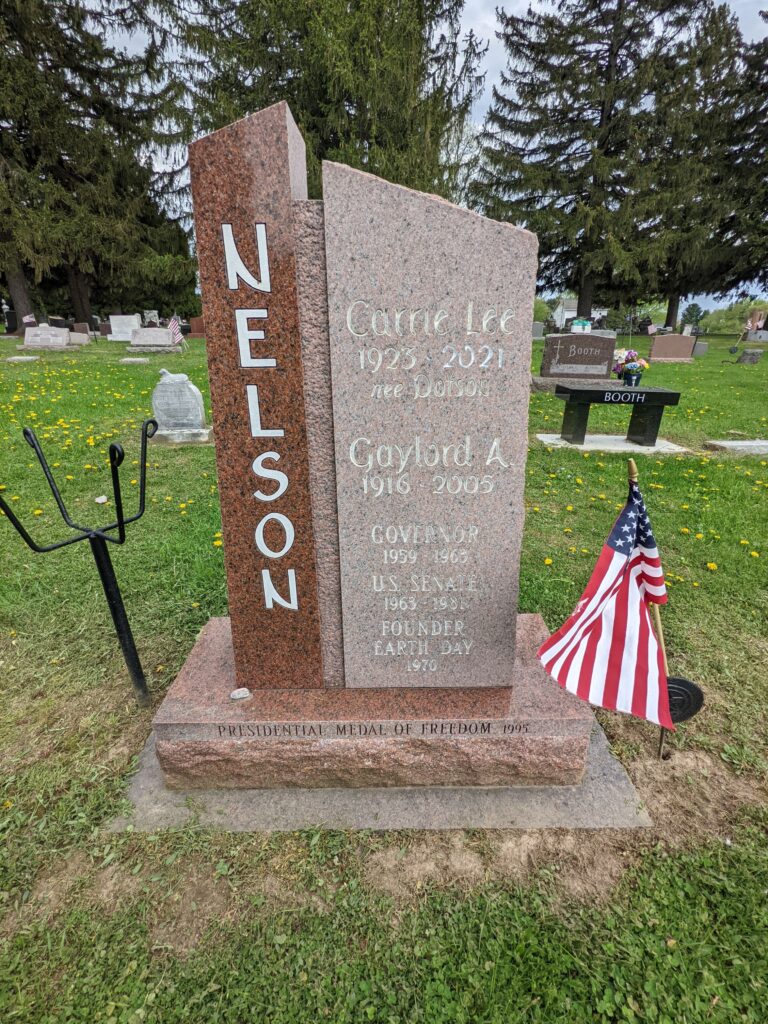Erik Visits an American Grave, Part 443
This is the grave of Gaylord Nelson.
Born in 1916 in Clear Lake, Wisconsin, Nelson ended up going to college at what is today San Jose State University in California, graduating in 1939. He returned to Wisconsin for law school and graduated from the University of Wisconsin with that degree in 1942. He practiced for awhile but ended up in the military for awhile and served in Okinawa during the latter period of World War II.
Politically ambitious, Nelson ran for the Wisconsin state Senate as a Democrat in 1948. This was the same period when Wisconsin was also elected Joseph McCarthy statewide, but then Wisconsin has frequently elected both some of the most progressive and most reactionary politicians in the country, often at the same time. He won and served five terms. He then became the state’s governor in 1958, only the second Democrat to ever win that office. He was a classic New Deal liberal who believed in high taxation on the rich to create a strong welfare state. He was also a big time conservationist at the time that this movement was really getting off the ground. He was particularly interested in expanding Wisconsin’s state parks at a time when union contracts and a growing middle class led to a lot more use of Wisconsin’s many natural spaces for recreation. He reorganized the state’s environmental arms of government into a new Department of Resource Development and established a Youth Conservation Corps to employ unemployed young people in building up the state’s environmental infrastructure. The state had two-year terms at the time and so he won reelection in 1960 and then ran for the Senate in 1962, again on a conservationist platform.
Nelson won that race too and would remain in the world’s worst deliberative body until he lost his reelection bid in 1980. As a senator, he became the single biggest voice for environmentalism in the Senate’s history. He convinced John F. Kennedy to engage in a speaking tour around environmental issues. Amusingly, in 1968, Green Bay Packers coach Vince Lombardi introduced Nelson in a speech, calling him the “nation’s #1 conservationist.” His campaign then used it in a commercial. But Lombardi was a huge right-wing Republican and was furious that his rather pro forma speech introduction was used by a candidate he would never vote for.
But it wasn’t just environmentalism that motivated Nelson. He was also fighting for anti-poverty programs, which he connected to the environment. He realized that the environment wasn’t just spaces for hunting and hiking. It was the rats in inner-city housing. To him, all forms of environment needed to be reformed and rehabilitated. He was a close ally of LBJ in the War on Poverty and stated, “Environment is all of America and its problems. It is rats in the ghetto. It is a hungry child in a land of affluence. It is housing not worthy of the name; neighborhoods not fit to inhabit.” He pushed for job training for the poor in environmental jobs as well. He also was an early opponent of the Vietnam War, which alienated him from a lot of Democratic leaders.
Frustrated with how Vietnam had taken attention away from environmental issues, Nelson, working with environmental activists, came up with the idea of Earth Day, a single day in which people across the country would hold mass actions to raise attention about environmental issues. This happened on April 22, 1970. Today, Earth Day barely registers, a corporate-friendly day that focuses on recycling programs and the like, challenging absolutely nothing. It’s a shell of what it was in 1970. That day, it was genuinely intended to be a radical challenge to an economic and political system despoiling the planet. What happened at the various rallies depended on who organized them and where they were, but some openly challenged capitalism and heckled corporate people trying to hijack it. It made Nelson a national figure.
Nelson built on the massive success of Earth Day by spending the next decade as a critical figure in passing many of the nation’s environmental laws, including multiple Clean Water Acts, the Federal Pesticides Act, the Clean Air Act, and the National Wild and Scenic River Act. He also brought a bit home to Wisconsin, getting the Apostle Islands National Lakeshore established as a unit of the National Park Service.
Nelson was also interested in other issues. He held hearings on the safety of birth control pills, leading to the law that required the listing of side effects. He was also a major advocate for small business and became chairman of the Small Business Committee, worked for the first White House Conference on Small Business, and other relatively small but significant laws and regulations to help them.
Nelson finally lost his 1980 re-election bid, when the Reagan election pulled lots of Republicans across the finish line, including Bob Kasten, who was a return to the awfulness that Wisconsin politics can so often be. Bill Clinton awarded Nelson the Presidential Medal of Freedom in 1995. He remained active in environmental causes for the rest of his long life. He did trend toward the population control side of environmentalism, which has long been a problem for that movement since it always targets the poor. There were and are certainly worse than Nelson on this issue, but arguments for national population stabilization often trend into anti-immigration politics. He died in 2005.
Gaylord Nelson is buried in Clear Lake Cemetery, Clear Lake, Wisconsin. What you can’t read on the grave, under the “Founder” is “Earth Day.”
If you would like this series to cover more senators of the 1970s, you can donate to cover the required expenses here. Strom Thurmond is in Edgefield, South Carolina and everyone wants that grave visit. Wayne Morse is in Eugene, Oregon. Previous posts in this series are archived here.




